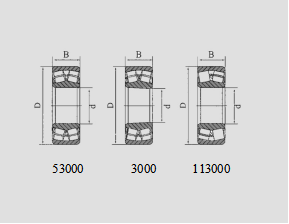
Nov . 04, 2024 17:31 Back to list
Understanding Axial Load Capacity of Spherical Roller Bearings in Mechanical Applications
Understanding Spherical Roller Bearings and Their Axial Load Capabilities
Spherical roller bearings are a critical component in many industrial applications due to their unique design and ability to support both radial and axial loads. These bearings are often utilized in heavy machinery, automotive applications, and various other sectors where robustness and reliability are paramount.
Design Characteristics
The spherical roller bearing consists of an inner ring, an outer ring, and a set of lubricant-filled spherical rollers. One of the defining features of these bearings is their ability to accommodate angular misalignment between the shaft and housing. This capability is due to the spherical shape of the outer ring and the rollers, which allows for movement in multiple directions. This design also helps to distribute loads evenly across the bearing surfaces, enhancing its performance and longevity.
Spherical roller bearings are typically designed with two rows of rollers, which increases their load-carrying capacity compared to single-row designs. Additionally, these bearings can handle both radial loads (forces acting perpendicular to the shaft) and axial loads (forces acting parallel to the shaft), making them versatile for various applications.
Axial Load Capabilities
Axial loads can be particularly challenging for many types of bearings. These loads are common in applications where components are subjected to significant thrust or pushing forces. Spherical roller bearings are engineered to handle such loads effectively, making them ideal for applications involving heavy machinery, like gearboxes, conveyor systems, and fans.
The axial load capacity of a spherical roller bearing is influenced by several factors, including the size and number of rollers, the contact angles, and the materials used in the bearing's construction. Larger rollers and optimal raceway designs enhance the load capacity, allowing the bearing to withstand higher thrust levels without compromising performance.
When selecting a spherical roller bearing for a specific application, it's crucial to consider both the radial and axial load requirements. Manufacturers provide detailed load ratings that indicate the maximum loads the bearing can handle under various conditions. It's advisable to work with these ratings closely to ensure that the bearings will perform reliably and efficiently throughout their intended lifespan.
spherical roller bearing axial load

Applications of Spherical Roller Bearings
Spherical roller bearings are prevalent in industries such as
1. Mining and Construction Here, heavy machinery is subjected to significant loads and harsh conditions. Spherical roller bearings can handle the immense forces and vibrations associated with mining equipment, making them a preferred choice.
2. Automotive Industry They are widely used in vehicle hubs and transmissions, where both radial and axial forces come into play. Their design helps maintain performance in varying load conditions.
3. Power Generation Wind turbines and hydroelectric facilities utilize spherical roller bearings due to their ability to accommodate dynamic loads and misalignment, ensuring smooth operation in challenging environments.
4. Agriculture Agricultural machinery, such as tractors and harvesters, benefits from the durability and reliability of spherical roller bearings, particularly in the demanding conditions of farming.
Maintenance and Longevity
To ensure the longevity and reliability of spherical roller bearings, regular maintenance is essential. This can include periodic inspections for wear, ensuring proper alignment, and monitoring lubrication levels. Proper lubrication is crucial, as it helps to reduce friction and wear between moving parts, thereby extending the bearing's life.
In conclusion, spherical roller bearings are integral to a multitude of applications due to their ability to handle both radial and axial loads effectively. Their unique design allows for accommodation of misalignment and offers considerable load-carrying capabilities. As industries continue to evolve and machinery becomes more complex, the importance of selecting the right bearing type—along with proper maintenance practices—will remain critical for ensuring operational reliability and efficiency. Understanding these bearings can help engineers and technicians make informed decisions that impact the performance of their machinery and equipment in real-world applications.
Latest news
-
Premium Deep Groove Ball Bearings | High Speed & Reliability
NewsAug.29,2025
-
Durable Scaffolding Clamps - Secure & Reliable Tube Connectors
NewsAug.28,2025
-
Common Failures in Thrust Ball Bearings and Solutions
NewsAug.22,2025
-
How Tapered Roller Bearings Can Take Shock Loads
NewsAug.22,2025
-
Angular Bearings in High-Precision Spindles
NewsAug.22,2025
-
The Impact of Misalignment on Cylindrical Roller Bearing Performance
NewsAug.22,2025
